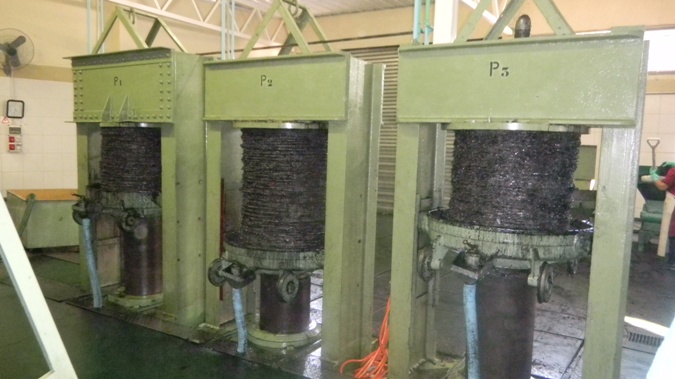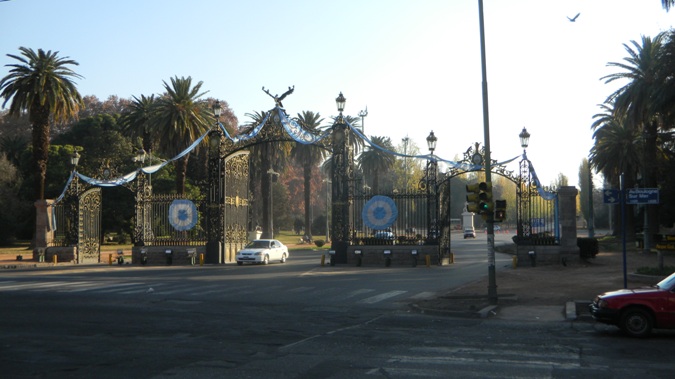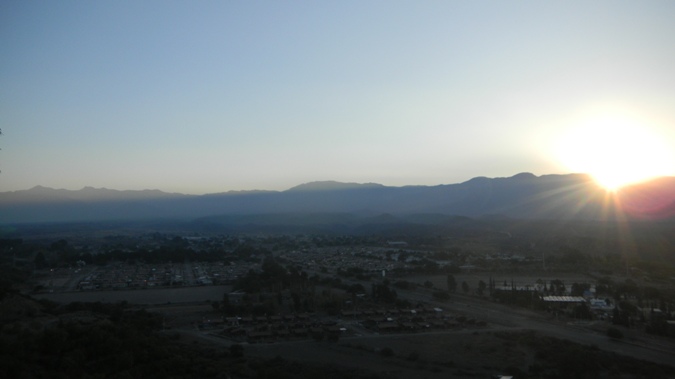Mendoza, wine (and olive oil) country!
Giving much thought to what places I wanted to see while in South America and thinking hard about my priorities in Argentine experiences, I planned and traveled my first trip to the heart of Argentine wine country. The provincial capital of Mendoza is to the west and south of Cordoba, in the foothills of the Andes. I enlisted the help of a travel agency in the mall that's down the street - I wasn't going to risk using my Spanish skills alone and ending up stuck in the middle of nowhere. They helped me arrange bus tickets, a hostel, and two day tours, leaving the taxis between the bus station and hostel as the only thing for me to take care of. I paid about 150$ American for this whole package.
I caught my colectivo - the Argentine term for large, public-use buses - from the Cordoba bus station at 10pm last Friday night. In Latin America, bus companies tend to be the best way to get around on longer trips - they are very cost effective and offer flying-first-class quality accomodations on double decker coach buses. My tickets weren't quite that swanky but the chair was big and reclined well, with a leg-rest and everything. The bus ride was about 10 hours, from 10:30 at night until 8:30 in the morning. Sleeping through the trip on that bus was not nearly as difficult as it sounded. For those reading this and thinking of travelling, I rode Chevallier which was alright - I hear that El Practico is the preferable line.
Arriving in Mendoza I caught a cab to my hostel, and from there left for my wineries tour package, to see how Argentina sizes up to our very own Williamsburg Winery. We started by visiting a newer modern winery called Vistandes (Vista-Andes, view of the Andes...which it did indeed have). We got a tour of their very new and clean-lined facilities, a look at their vines which are a bit depressingly brown and drying in this season, and to taste their Torrontes and their Malbec. They were both very good - these wineries are a bit different from some you'd find in Virginia for a number of reasons, for example that they grow a lot of their own grapes and that they hand-pick them. Here is a picture of me in their fermenting barrels cellar:

From there we went onto a olive-oil producing factory called Pasrai, which is a 5th-generation family operation. We could see many olive trees from the road, and got to see one up close in their courtyard. Olive oil is also a very big part of industry in the province of Mendoza. We saw how they take the olives (olives are green when underripe and black when ripe, best for oil production), turn them into a slurry, spread the slurry onto discs, stack the disks, and then press the oil out which trickles down the sides. Then they purify and change the oil depending on what kind of EVOO they are producing. Here is an image of three of the presses:

From there we got to go to the tasting room and taste various products, which were all delicious and flavorful.
The last winery we visited on the trip was an older winery that produced only reds, Cavas Don Arturo. They also showed us around their facility, which dated from about 1930 and had a much more aged and classic feel. We got to sample a few of their wines which were as equally delicious as everything else on the excursion. They had a room with the relics of their earliest years of production, including the giant wine barrels:

And with that my first day in Mendoza ended and I returned to the hostel.
My second day I took a city tour. The guide showed us around with both walking and bus parts to the excursion, telling us all about the parts of the city, the big plazas, the important buildings, and about its history as well. Mendoza is quite different from Cordoba - the buildings are not as tall, the streets are broad and tree-lined, and it has a greater feeling of calm and grandeur than does the busy and hectic Cordoba. The province of Mendoza is also very arid, and the entire water supply is fed by an irrigation system of canals and channels that you can see running along the city and countryside. Mendoza also has a rich history and feels very connected to the great liberator of the southern part of South America, San Martin. Here is a picture of the entrance to the large park in Mendoza, their Central Park if you will:

After this we visited the Cerro La Gloria, a mountain nearby Mendoza and saw a beautiful monument there in addition to breathtaking views of the city and Andes mountains. And with that ended my short weekend trip - I hopped my colectivo back to Cordoba that night and was back in town by 9am Monday, just in time to enjoy the feriado - holiday - national Flag Day. They tell me Argentines will find any reason to celebrate. So what's the take-away from this blog post? Come and find me when I'm back in Williamsburg, because with all the souvenirs I brought back from this side trip I will be having some pretty classy (and delicious) parties. I'll leave you with a parting view of the Andes from Cerro La Gloria.
Nos vemos (See ya soon!),
Catherine

P.S. The scene in the foreground isn't the city of Mendoza but rather the outskirts - Mendoza is on the other side of the mountain.